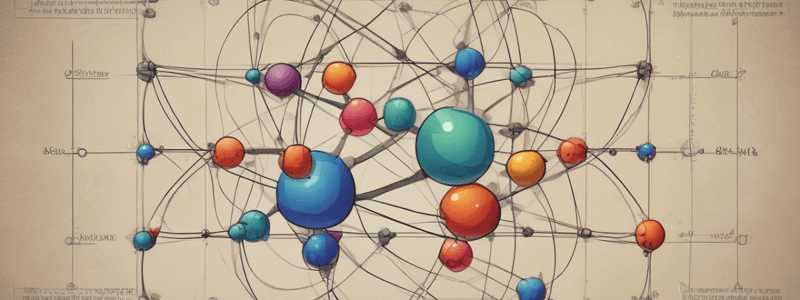Podcast
Questions and Answers
What is the smallest unit of a chemical element that retains the properties of that element?
What is the smallest unit of a chemical element that retains the properties of that element?
- Atom (correct)
- Element
- Compound
- Molecule
What is the positively charged particle in the nucleus of an atom?
What is the positively charged particle in the nucleus of an atom?
- Molecule
- Electron
- Neutron
- Proton (correct)
What is a substance that consists of only one type of atom?
What is a substance that consists of only one type of atom?
- Element (correct)
- Molecule
- Compound
- Mixture
What is the term for the force that holds atoms together in a molecule or compound?
What is the term for the force that holds atoms together in a molecule or compound?
What is a notation that represents the ratio of atoms in a molecule or compound?
What is a notation that represents the ratio of atoms in a molecule or compound?
What is the sum of the atomic weights of all atoms in a molecule or compound?
What is the sum of the atomic weights of all atoms in a molecule or compound?
What is an example of a molecule composed of different elements?
What is an example of a molecule composed of different elements?
What is a substance formed by the chemical combination of two or more different elements?
What is a substance formed by the chemical combination of two or more different elements?
Flashcards are hidden until you start studying
Study Notes
Atomic Structure
- An atom is the smallest unit of a chemical element that retains the properties of that element.
- Atoms consist of:
- Protons: positively charged particles in the nucleus (center) of the atom.
- Neutrons: particles with no charge in the nucleus.
- Electrons: negatively charged particles orbiting the nucleus.
Elements
- An element is a substance that consists of only one type of atom.
- Elements are represented by a unique symbol (e.g., H for Hydrogen, C for Carbon).
- Elements can exist in different forms, called isotopes, which have the same number of protons but a different number of neutrons.
Molecules
- A molecule is a group of two or more atoms chemically bonded together.
- Molecules can be composed of atoms from the same element (e.g., O2) or different elements (e.g., H2O).
- Molecules have a fixed ratio of atoms, which is represented by a chemical formula (e.g., H2O for water).
Compounds
- A compound is a substance formed by the chemical combination of two or more different elements.
- Compounds have a fixed ratio of atoms, which is represented by a chemical formula.
- Compounds have properties that are different from their individual component elements.
Key Concepts
- Chemical bond: a force that holds atoms together in a molecule or compound.
- Chemical formula: a notation that represents the ratio of atoms in a molecule or compound.
- Molecular weight: the sum of the atomic weights of all atoms in a molecule or compound.
Examples
- Element: Oxygen (O)
- Molecule: Oxygen molecule (O2)
- Compound: Water (H2O)
- Molecule composed of different elements: Carbon dioxide (CO2)
Atomic Structure
- An atom is the smallest unit of a chemical element that retains its properties.
- Atoms consist of protons, neutrons, and electrons, with protons and neutrons in the nucleus and electrons orbiting around it.
Elements
- An element is a substance made up of only one type of atom.
- Each element has a unique symbol, such as H for Hydrogen and C for Carbon.
- Elements can exist in different forms called isotopes, which have the same number of protons but a different number of neutrons.
Molecules
- A molecule is a group of two or more atoms chemically bonded together.
- Molecules can be made up of atoms from the same element or different elements.
- The ratio of atoms in a molecule is represented by a chemical formula, such as H2O for water.
Compounds
- A compound is a substance formed by the chemical combination of two or more different elements.
- Compounds have a fixed ratio of atoms, which is represented by a chemical formula.
- Compounds have properties that are different from their individual component elements.
Key Concepts
- A chemical bond is a force that holds atoms together in a molecule or compound.
- A chemical formula is a notation that represents the ratio of atoms in a molecule or compound.
- Molecular weight is the sum of the atomic weights of all atoms in a molecule or compound.
Examples
- Oxygen is an element with the symbol O.
- Oxygen molecule (O2) is an example of a molecule made up of atoms from the same element.
- Water (H2O) is an example of a compound made up of hydrogen and oxygen atoms.
- Carbon dioxide (CO2) is an example of a molecule made up of atoms from different elements.
Studying That Suits You
Use AI to generate personalized quizzes and flashcards to suit your learning preferences.




